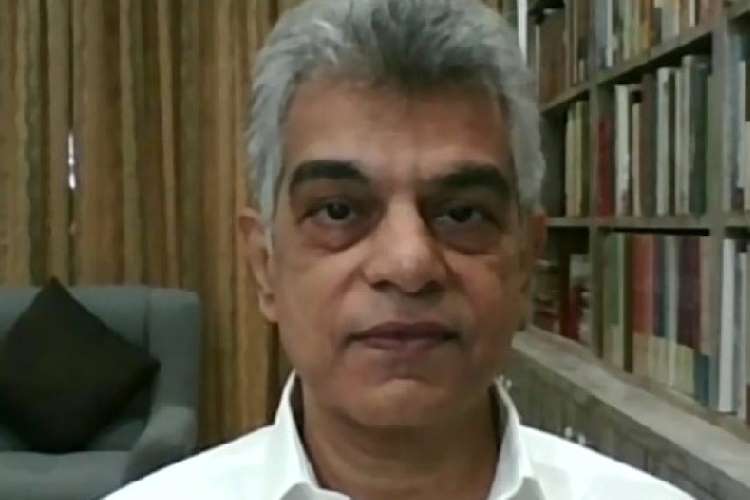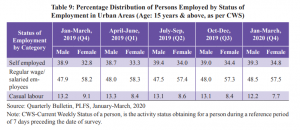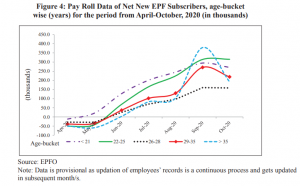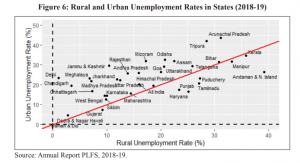
India’s demographic dividend: India’s unemployment rate shot up to 7.8% in June 2022 with some 13 million jobs lost, mostly in the agriculture sector. What is the matrix of employment and unemployment in this country? Apart from self-employment, what jobs can the government and private sector potentially provide? What does that universe look like today, and what could it look like tomorrow? The government has to not only create jobs, it also has to create an enabling environment to ensure that the private sector finds it profitable to invest and hire people in good quality jobs, says CMIE Managing Director and CEO Mahesh Vyas. Edited excerpts of an interview:
Out of a population of 1.3 billion, who are the people actively looking for jobs, and what is the proportion of people searching for jobs?
Out of 1.3 billion people in India, just a billion matter [in the context of] labour markets. These are people aged 15 years or more. We don’t count those below 15 years of age as being in the labour markets, [which leaves] about a billion people. A fairly large proportion of this billion choose not to work for profit, or for wages. So, the number of people who come to the labour market to find a job–to work for somebody else for wages, plus the self-employed who work for themselves for profit–becomes your labour force.

The labour force in India has been in the vicinity of around 430-450 million. Thus, of a billion people who are more than 15 years old, about 44-45% are offering themselves to work for wages or for profit. Those who are working at home, just taking care of themselves, their household, family, their kids, the elderly, are not a part of the labour force, per convention. Only those who intend to go out to work for wages or for profits are counted as part of the labour force. So that’s some 430-440 million.

READ I Demographic dividend: Can India benefit from its young population
Of these, about 30-40 million don’t find jobs. Thus, the country is able to offer jobs only to around 400 million people. That’s the number of people who are employed in the country. In the June numbers you mentioned, that number had fallen quite substantially, to 390 million. So those are the broad numbers, the labour force is around 430-440 million out of a billion people who are more than 15 years old, around 400 million people are employed and 35 million are unemployed.

You said about 44% of people aged 15 years and above offer themselves for work. So, there are another 60% who are dependent on these 44%. Does that percentage or ratio mostly remain that way?
Well, that’s the way it remains in India. The problem is the ratio of dependence actually keeps increasing. Also, the [proportion of dependents] is more than 60%, because all those aged less than 15 years are also dependents.
It sounded like you said the labour force, or the number of people who have offered themselves for work, has been 430-440 million-strong for some years now.
That’s right. This number hasn’t grown much. And if you look at the proportion of people aged above 15 years who are offering themselves in the labour market, that proportion has been falling. It used to be around 44-45%; it’s now down to 39%. The proportion matters a lot. The proportion of people more than 15 years old offering themselves for work is called the labour force participation rate. That participation rate has fallen.
How long has the labour force been in this range of 430-440 million?
CMIE has been tracking this from 2016. It’s been in this range since then.
If despite an increasing population and a greater number of people entering the employable age category, the size of the labour force is roughly the same [since 2016], what does that indicate?
It indicates that India is not generating sufficient jobs for the number of people who are coming, potentially, into the labour market. Thereby, we are losing our demographic dividend. India is in this beautiful window [period] where we are offering lots of young men and women who are employable. If these people get employed, [if] India generates a lot more income, their households will get income and savings. But if you don’t provide them with jobs, then neither do they get an income, nor do they get savings for their future.
Of the 430 million, you said roughly 30 to 40 million are unemployed, i.e. they are actively looking for jobs but not finding them? But you’re also saying that, since 2016, the aggregate labour force has remained at 430 million. Are we seeing this consistent figure because people are not offering themselves in the job market? And if they were, then the number of unemployed would have been much higher?
That’s right, the number of unemployed would have been much higher. The reason why [the aggregate labour force] has remained as stable as it has, is because people get dejected. They come to the labour markets, they don’t find enough jobs, can’t hang around there for too long and finally say that they’re not looking for a job. This is happening particularly in the case of women. They feel that getting jobs is so difficult, it’s not even worth offering services in the labour market.
What should policy address, these 30-40 million unemployed in the job market, or also those who are staying out of the labour market for the reasons you just mentioned?
Policy should address the issue of the demographic dividend. Policy should address the opportunity which India has, that it is producing a large labour force that needs to be deployed for the benefit of the people of the country. That is the most important thing. Because this is a once in a multi-generation lifetime period that you get this window, when you have this [huge number] of working age people. Policy should just address that.
READ I Time for govts, businesses to revive skilling efforts
Policy also doesn’t have to address only employment. Policy should be aimed at ensuring good quality jobs, good wages, stable jobs, which generate savings for a better future. For instance, you can get jobs by pushing a cart down the street, or hawking some odd items, but those are not the kind of jobs we should aspire for, or that policy should be aiming at.
Let’s look at where more jobs could come from. The central government, by its own admission, has close to 800,000 vacant positions. Every state government has vacant positions, including in education, healthcare and law enforcement. Plenty of statistics suggest that there could be several million jobs there too. So what is the ability of the government to fill this 20 to 30 million unemployment gap?
This is, I think, one of the most important questions that our country needs to answer. We are in a situation where the government is unable to provide the services that it ought to provide to us. For example, we are unable to get adequate services from the government in respect of security, or the judiciary. Further, the quality of water we get, the quality of education and primary health centres, leaves a lot to desire.
The government is in a situation where it cannot hire people to provide those services, because its finances are far too constrained. The problem is that the [government’s] pension liability has grown so much that it can’t afford those people. Thus I think we require major reform, of government, its services, and the sustainability of those services.
To the best of my understanding, the proportion of people employed in government in India is amongst the lowest in the world. In most countries, particularly developed countries, the proportion of people hired in government is much higher, and those governments do provide a lot more services to their people.
Here we have a situation where the government is unable to meet its basic requirements towards its citizens. Therefore, it has a large number of vacancies, which it is unwilling to fill because it can’t afford to. It acknowledges that there are vacancies, but is unable to figure out how it will foot the bill to fill these. Maybe it can foot the bill for one year because it was budgeted, but it cannot foot the bill for pensions.
One in six teaching positions and one in five police positions in this country are vacant. Yet there is also a common perception that the government in India is overstaffed, whether at the central or state level. But what you’re saying right now, is that it’s the opposite.
Yes, the government is not overstaffed and is also under-utilising the staff it has. This requires correction on both fronts. There are lots of government servants who are lacking in application, who are working inefficiently. There’s a need to streamline their work. I don’t think there are inefficient people but inefficient systems which must be streamlined, and the government needs to hire more people.
The government has recently announced a target of filling one million vacancies over the next 18 months, and also announced the army recruitment scheme, or Agniveer. What do you think of these announcements, from a macro jobs policy perspective?
The announcement from the Prime Minister’s office regarding a million government jobs being provided in the next one-and-a-half years is nothing short of dramatic. It can make a huge difference, because these are the best quality jobs available today. A good quality job in the government is like a dream come true for many people. If that really happens, and I do not know how they’re going to solve the affordability on the pensions front, it will make a very huge difference. It’ll be important for the government to sort this out and think it through correctly, but insofar as the labour markets and jobs are concerned, it’s going to make a huge difference.
About Agniveer, I am not in a position to comment on the impact of that on the armed forces. Only people who are in the armed forces or experts can comment on that. So I’ll refrain from doing that because I don’t know. But I can say one thing, that it has dashed the hopes of many people in many parts of the country, who were preparing for a career in the armed forces but when it came to the hiring part, at the last moment, the rules were changed, and a lot of people felt shortchanged.
So, I think an important lesson to learn over here is not to throw such surprises, on the downside. That’s the only point. I don’t think it’s a good thing for people to work so hard towards getting admission into the armed forces, and then feel they’re not going to get it.
Going back to that 20 to 30 million people who are unemployed, the number of government jobs available, through army recruitment for instance, doesn’t seem enough–assuming also that those who are already employed won’t want these jobs, though it is likely that they will.
No, it isn’t much, but it makes a material difference to a very large number of people, [considering] the multiplier effect of [these government jobs]. If you get a job to deliver milk in the neighbourhood, it won’t make a big difference to your family. But if you get a job in the armed forces, you can make a material difference to your entire family and even beyond. That’s the potency of that [armed forces] job. So the damage it does when the rules of the game change is much more than for [other] kinds of jobs.
Mind you, the people who were going to take these jobs are mostly young men aged 18 to 21. It’s a very different bracket. They weren’t looking to graduate and get office jobs. They were clearly focused on getting into the armed forces.
What proportion of the 420-430 million employed are in the organised sector versus unorganised, and government versus non-government?
Organised is about 20% and the rest is unorganised. I don’t have the number for government share readily available, but if organised is 20%, obviously the government is a significant proportion of that.
What’s the role and the likely contribution of the private sector to adding jobs, in today’s scenario?
I think there is a difference in the way we look at the private sector and the government sector. The private sector has no responsibility towards providing jobs. It requires incentives, or rather an enabling environment, to provide jobs. Government, on the other hand, is responsible for creating the environment that motivates the private sector to invest, which can create jobs. Thus, the government has the heavier responsibility. It’s not only the case that the government has to provide its own jobs, it also has to create the enabling environment to motivate the private sector to create more jobs.
The private sector is only going to react to a situation. If the environment is conducive towards long-term investments and better quality jobs, they will do it. If they find that the environment is not conducive to that, maybe because of the fear of tax authorities, or because the markets are not good enough, or maybe there is too much uncertainty in the external environment, [they won’t]. It’s the government’s responsibility to ensure that the private sector finds it profitable to invest and to hire people in good quality jobs.
Tata Consultancy Services recently announced that they’ve crossed the mark of 600,000 employees. Who could have ever imagined that a private company would be larger than any government organisation? On the other hand, we are unlikely to see this kind of job creation elsewhere, perhaps for productivity and technology reasons, or do you feel otherwise?
I don’t see a reason why it cannot be replicated elsewhere. Enterprises just need to see the advantage of doing large-scale hiring. If TCS can do it for software, if an enterprise is willing to hire so many people under one roof, we should learn lessons from this and exploit the opportunity of India having a large contingent of young, employable people. I don’t see a reason why we should believe that it’s not possible elsewhere.
The number of unemployed went up quite dramatically, by more than 10 million, in June. What’s the prognosis for the coming months, particularly through the monsoon period?
We shouldn’t focus too much on the loss of jobs in June, as I have written that it’s transitory. People have quit their jobs as daily wage labourers in some parts of the economy, and have moved to becoming agricultural labourers in the current sowing season. The rains, however, were delayed. As a result, they were left unemployed, or they left the labour markets. They know that there’s employment coming up, though delayed by a few weeks. As the rains have started, the labour participation rate in agriculture, or rather in rural India, has started rising. Hence, those 13 million people who lost jobs in the month of June, will very likely be back in employment as agricultural labourers in July.
(Published in an arrangement with IndiaSpend.)
Govindraj Ethiraj is a journalist and entrepreneur based in Mumbai. He has over 25 years experience with India's top print and TV platforms. He is the founder of public interest journalism ventures such as IndiaSpend, FactChecker and BOOM.

